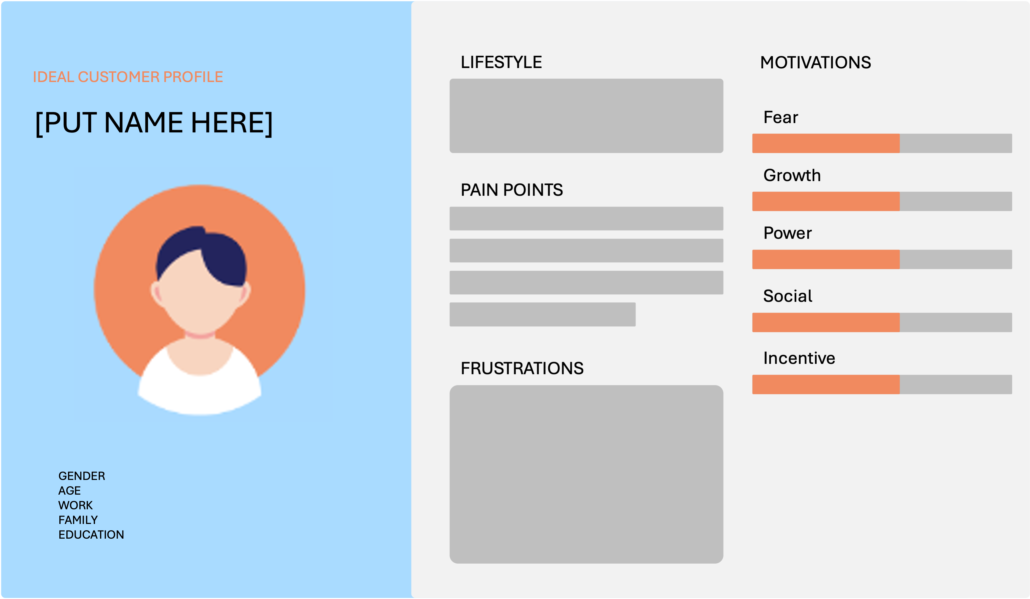Identify your Ideal Customer Profile (ICP)

How to Identify Your Ideal Customer Profile (ICP): A Step-by-Step Guide for Insurance Agency Owners
As an insurance agency owner, understanding your Ideal Customer Profile (ICP) is crucial for effective marketing and business growth. But what exactly is an ICP, and how do you determine who your ideal customer is? Don’t worry—you’re not alone. Identifying your ICP is a vital step in understanding your audience and tailoring your services to meet their needs.
In this guide, we’ll walk through each step of creating your ICP specifically for the insurance industry, helping you build stronger marketing strategies and improve your client acquisition efforts.
Step 1: Understand What an ICP Is
Your ICP is a detailed description of the customer who would benefit the most from your insurance services. This isn’t just any customer; it’s your best-fit customer—one who is likely to remain loyal, refer others, and maximize the value they get from your policies.
For insurance agencies, your ICP helps you focus your marketing efforts on those clients who are not only likely to convert but who also align with your agency’s values and services. By identifying your ICP, you can create more targeted marketing strategies and enhance your service offerings.
For further reading on understanding ICPs, check out this HubSpot guide.

Step 2: Analyze Your Existing Customers
A great starting point for identifying your ICP is to analyze your current clients. Consider these steps:
- Create a Customer Database: Compile a list of your existing clients, noting their demographics, types of insurance purchased, and any other relevant information such as claims history and policy renewals.
- Segment Your Customers: Group your clients into categories based on similar characteristics. This could include:
-
- Type of Insurance: Are they primarily auto, home, business, or life insurance clients?
- Claim Frequency: Which customers have claimed frequently, and how does that affect their loyalty?
- Payment Timeliness: Who pays their premiums consistently on time.
- Identify Trends: Look for patterns among your best customers. For instance, do clients in certain industries or demographics tend to purchase more comprehensive coverage?
*Tool tip*: Use a CRM tool like HubSpot CRM or Salesforce to help analyze customer data. (We use Hubspot here at Goma Marketing.)
Step 3: Define Key Demographics and Firmographics
After analyzing your existing customer base, it’s important to define specific demographic and firmographic characteristics:
-
Demographics: For individual clients, determine:
- Age: What age range do your ideal customers fall into? Are they young adults buying their first policies, families securing their homes, or retirees seeking life insurance?
- Gender: Does your agency cater to a specific gender more than the other?
- Income Level: Understanding the financial situation of your clients can help tailor your offerings and premiums.
- Geographic Location: Are your clients primarily located in urban areas, suburban communities, or rural regions?
-
Firmographics: If you deal with businesses (B2B), focus on:
- Industry: What industries are your ideal business clients in? Are they small businesses, tech startups, or large corporations?
- Company Size: What is the average employee count of your best clients?
- Revenue Range: Understanding the financial capacity of your business clients can guide your premium pricing strategies.

Step 4: Dive Into Customer Pain Points and Needs
Understanding your customers’ pain points is crucial in the insurance industry. Here’s how to uncover them:
-
Identify Common Challenges: What problems do your clients typically face? This could include confusion over policy details, a need for personalized guidance during claims, or concerns about inadequate coverage.
-
Evaluate Their Goals: What are your clients trying to achieve? This might include securing the best rates for their premiums, obtaining comprehensive coverage, or ensuring their assets are protected.
-
Gather Feedback: Reach out to your customers through surveys or informal discussions to learn more about their needs and challenges. Ask questions like:
- What do you wish your insurance provider would do differently?
- What factors influence your decision to choose an insurance agency?
Knowing your customers’ pain points will help you craft an accurate ICP and develop targeted marketing messages.
Step 5: Conduct Surveys and Interviews
Asking your customers directly is one of the best strategies to understand their needs. Here’s how to effectively conduct surveys and interviews:
-
Design Your Survey: Keep it concise but focused on understanding customer demographics, pain points, and preferences. Consider including questions related to their insurance needs and their satisfaction with current services.
-
Choose the Right Tool: Use platforms like SurveyMonkey or Google Forms to create and distribute your survey effectively.
-
Analyze Feedback: Once you’ve gathered responses, categorize and analyze the data to identify trends in customer needs, expectations, and experiences.
-
Conduct One-on-One Interviews: Consider having in-depth conversations with select customers to gain insights that surveys might miss. Prepare a list of questions and engage in a dialogue to better understand their motivations.
Not sure what questions to ask? This article on can help you get started.

Step 6: Evaluate Your Competitors’ Customers
Understanding your competitors can provide additional insights into your target market. Here’s how to analyze your competition effectively:
-
Identify Key Competitors: Make a list of your primary competitors in the insurance market.
-
Analyze Their Target Audience: Research who their ideal customers are. What demographics are they targeting? What types of insurance do they offer?
-
Review Customer Feedback: Look at reviews, testimonials, and feedback on competitor websites and social media pages. This can reveal insights into what customers appreciate or dislike about their services.
-
Identify Gaps in the Market: Use this analysis to identify potential gaps in the market that your agency can fill. Are there underserved segments that your competitors are overlooking?
Step 7: Narrow It Down with Data
With a wealth of information about your best customers, it’s time to synthesize that data into a usable profile:
-
Create a Summary Document: Compile all the demographic, firmographic, and psychographic details into a single document that outlines your ideal customer.
-
Visualize the ICP: Use charts or graphs to visualize the key attributes of your ICP. This could include pie charts representing demographic breakdowns or profiles that highlight common pain points.
-
Define the Ideal Customer: Write a narrative that describes your ideal customer, focusing on their needs, challenges, and how your services can address them. This narrative will serve as a reference point for all your future marketing efforts.
The more precise you are, the easier it will be to attract those customers.
Final Thoughts
Identifying your ICP is a crucial step to unlocking better marketing results for your insurance agency. By following these steps, you’ll be on your way to understanding your ideal customer and tailoring your messaging to reach them effectively. Remember, building your ICP takes time and effort, but the payoff is well worth it.



